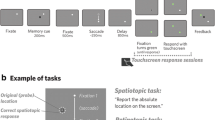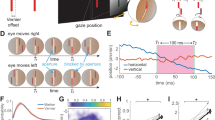Abstract
Interaction with everyday objects requires by the active visual system a fast and invariant reconstruction of their local shape layout, through a series of fast binocular fixation movements that change the gaze direction on the 3-dimensional surface of the object. Active binocular viewing results in complex disparity fields that, although informative about the orientation in depth (e.g., the slant and tilt), highly depend on the relative position of the eyes. Assuming to learn the statistical relationships between the differential properties of the disparity vector fields and the gaze directions, we expect to obtain more convenient, gaze-invariant visual descriptors. In this work, local approximations of disparity vector field differentials are combined in a hierarchical neural network that is trained to represent the slant and tilt from the disparity vector fields. Each gaze-related cell’s activation in the intermediate representation is recurrently merged with the other cells’ activations to gain the desired gaze-invariant selectivity. Although the representation has been tested on a limited set of combinations of slant and tilt, the resulting high classification rate validates the generalization capability of the approach.
Access this chapter
Tax calculation will be finalised at checkout
Purchases are for personal use only
Similar content being viewed by others
References
Ban, H., Welchman, A.E.: fMRI analysis-by-synthesis reveals a dorsal hierarchy that extracts surface slant. J. Neurosci. 35(27), 9823–9835 (2015)
Canessa, A., Gibaldi, A., Chessa, M., Fato, M., Solari, F., Sabatini, S.P.: A dataset of stereoscopic images and ground-truth disparity mimicking human fixations in peripersonal space. Sci. Data 4 (2017)
Dhond, U.R., Aggarwal, J.K.: Structure from stereo-a review. IEEE Trans. Syst. Man Cybern. 19(6), 1489–1510 (1989)
Gibaldi, A., Canessa, A., Sabatini, S.P.: The active side of stereopsis: fixation strategy and adaptation to natural environments. Sci. Rep. 7, 44800 (2017)
Hansard, M., Horaud, R.: Cyclopean geometry of binocular vision. JOSA A 25(9), 2357–2369 (2008)
Hinkle, D.A., Connor, C.E.: Three-dimensional orientation tuning in macaque area V4. Nat. Neurosci. 5(7), 665–670 (2002)
Koenderink, J.J., van Doorn, A.J.: The internal representation of solid shape with respect to vision. Biol. Cybern. 32(4), 211–216 (1979)
Koenderink, J.J., van Doorn, A.J.: Facts on optic flow. Biol. Cybern. 56(4), 247–254 (1987)
Liu, L., van Hulle, M.M.: Modeling the surround of MT cells and their selectivity for surface orientation in depth specified by motion. Neural Comput. 10(2), 295–312 (1998)
LeCun, Y., Huang, F.J., Bottou, L.: Learning methods for generic object recognition with invariance to pose and lighting. In: 2004 Proceedings of the 2004 IEEE Computer Society Conference on Computer Vision and Pattern Recognition, CVPR 2004, vol. 2, pp. II–104. IEEE (2004)
Medsker, L.R., Jain, L.C.: Recurrent neural networks. Des. Appl. 5 (2001)
Nguyenkim, J.D., DeAngelis, G.C.: Disparity-based coding of three-dimensional surface orientation by macaque middle temporal neurons. J. Neurosci. 23(18), 7117–7128 (2003)
Rumelhart, D.E., Hinton, G.E., Williams, R.J.: Learning internal representation by back propagation. Parallel Distrib. Process.: Explor. Microstruct. Cogn. 1 (1986)
Salinas, E., Abbott, L.F.: A model of multiplicative neural responses in parietal cortex. Proc. Nat. Acad. Sci. 93(21), 11956–11961 (1996)
Tsao, D.Y., Vanduffel, W., Sasaki, Y., Fize, D., Knutsen, T.A., Mandeville, J.B., Wald, L.L., Dale, A.M., Rosen, B.R., Van Essen, D.C., Livingstone, M.S.: Stereopsis activates V3A and caudal intraparietal areas in macaques and humans. Neuron 39(3), 555–568 (2003)
Author information
Authors and Affiliations
Corresponding author
Editor information
Editors and Affiliations
Rights and permissions
Copyright information
© 2017 Springer International Publishing AG
About this paper
Cite this paper
Kalou, K., Gibaldi, A., Canessa, A., Sabatini, S.P. (2017). Learning a Compositional Hierarchy of Disparity Descriptors for 3D Orientation Estimation in an Active Fixation Setting. In: Lintas, A., Rovetta, S., Verschure, P., Villa, A. (eds) Artificial Neural Networks and Machine Learning – ICANN 2017. ICANN 2017. Lecture Notes in Computer Science(), vol 10614. Springer, Cham. https://doi.org/10.1007/978-3-319-68612-7_22
Download citation
DOI: https://doi.org/10.1007/978-3-319-68612-7_22
Published:
Publisher Name: Springer, Cham
Print ISBN: 978-3-319-68611-0
Online ISBN: 978-3-319-68612-7
eBook Packages: Computer ScienceComputer Science (R0)




